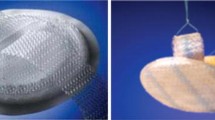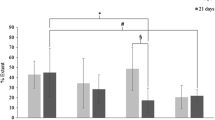Abstract
Introduction
The most common treatment option for ventral and umbilical hernias is the implant of a prosthetic mesh. This study compares the behaviour of a new mesh, Parietex™ Composite Ventral Patch (Ptx), with two commercially available meshes, Ventralex™ ST Hernia Patch and Proceed™ Ventral Patch.
Materials and methods
The following meshes were tested in a umbilical-hernia repair model using 54 rabbits: Ventralex™ ST Hernia Patch (Vent) (Bard Davol Inc., USA); Proceed™ Ventral Patch (PVP) (Ethicon, USA) and Ptx (Covidien, Sofradim, France) (n = 18 each). At 3, 7 and 14 days postimplantation, peritoneal behaviour and adhesion formation were assessed by sequential laparoscopy. Adhesions were scored for consistency and quantified by image analysis. The animals were euthanized at 2 (n = 27) and 6 weeks (n = 27) postsurgery. Mesothelial cover of meshes and tissue ingrowth were determined by scanning and light microscopy.
Results
Seroma was observed in 1/18 Vent, 7/18 PVP and 4/18 Ptx, mainly between the implant and subcutaneous tissue. Firm omental adhesions between the mesh and parietal peritoneum were noted in 2/9 Vent, 6/9 PVP and 3/9 Ptx at 2 weeks and in 3/9 Vent, 5/9 PVP and 1/9 Ptx at 6 weeks. Three (out of 9) encapsulated PVP implants showed “tissue-integrated” adhesions affecting the intestinal loops. No differences between implants were detected in the surface area occupied by adhesions at 2 weeks, though at 6 weeks, percentages were significantly higher (p < 0.01; Mann–Whitney U test) for PVP compared to Ptx or Vent. At this time point, Ptx and Vent showed good host tissue incorporation and optimal mesothelialization.
Conclusions
The PVP implants showed greater adhesion formation than the other materials. Postimplantation behaviour was comparable for Ptx and Vent including scarce adhesion formation and optimal mesothelialization. Regarding tissue integration, Ptx showed greater long-term collagenization of the neoformed tissue.






Similar content being viewed by others
References
Perrakis E, Velimezis G, Vezakis A et al (2003) A new tension-free technique for the repair of umbilical hernia, using the Prolene Hernia System, early results from 48 cases. Hernia 7:178–180
Lang B, Lau H, Lee F (2002) Epigastric hernia and its etiology. Hernia 6:148–150
Velasco M, García-Ureña M, Hidalgo M, Vega V, Carnerol F (1999) Current concepts on adult umbilical hernia. Hernia 3:233–239
Hidalgo M, Higuero F, Alvarez-Caperochipi J, Machuca J, Laprote E, Figueroa J (1996) Hernias de la pared abdominal. Estudio multicéntrico epidemiológico (1993–1994). Cir Esp 59:309–405
Lichtenstein IL, Shulman AG, Amid PK, Montlor MM (1989) The tension-free hernioplasty. Am J Surg 157:188–193
Bowley DMG, Kingsnorth (2000) Umbilical hernia, Mayo or mesh? Hernia 4:195–196
Arroyo A, Garcia P, Perez F, Andreu J, Candela F, Calpena R (2001) Randomized clinical trial comparing suture and mesh repair of umbilical hernia in adults. Br J Surg 88:1321–1323
Aslani N, Brown CJ (2010) Does mesh offer an advantage over tissue in the open repair of umbilical hernias? A systematic review and meta-analysis. Hernia 14:455–462
Celdrán BJ, Bazire P, García-Ureña MA, Marijuán JL (1995) H-hernioplasty: a tension-free repair for umbilical hernia. Br J Surg 82:371–372
Arroyo A, Pérez F, Serrano P, Costa D, Oliver I, Ferrer R, Lacueva J, Calpena R (2002) Is prosthetic umbilical hernia repair bound to replace primary herniorrhaphy in the adult patient? Hernia 6:175–177
Bellón JM, Contreras L, Buján J, Jurado F (1996) Effect of phosphatidylcholine on the process of peritoneal adhesion following implantation of a polypropylene mesh prosthesis. Biomaterials 17:1369–1372
Berrevoet F, Van den Bossche R, De Baerdemaeker L, De Hemptinne B (2010) Laparoscopic evaluation shows deficiencies in memory ring deployment during small ventral hernia repair. World J Surg 34:1710–1715
Muysoms FE, Bontinck J, Pletincks P (2011) Complications of mesh devices for intraperitoneal umbilical hernia repair: a word of caution. Hernia 15:463–468
Ben-Haim M, Kuriansky J, Tal R, Zmora O, Mintz Y, Rosin D, Ayalon A, Shabtai M (2002) Pitfalls and complications with laparoscopic intraperitoneal expanded polytetrafluoroethylene patch repair of postoperative ventral hernia. Surg Endosc 16:785–788
Hadi HI, Maw A, Sarmah S, Jumar P (2006) Intraperitoneal tension-free repair of small midline ventral abdominal wall hernias with a Ventralex hernia patch: initial experience in 51 patients. Hernia 10:409–413
Vychnevskaia K, Mucci-Hennekinne S, Casa C, Bracher D, Meunier K, Briennon X, Hamy A, Arnaud JP (2010) Intraperitoneal mesh repair of small ventral abdominal wall hernias with a Ventralex hernia patch. Dig Surg 27:433–435
Martin DF, Williams RF, Mulrooney T, Voeller GR (2008) Ventralex mesh in umbilical/epigastric hernia repairs: clinical outcomes and complications. Hernia 12:370–383
Ambe P, Meyer A, Köhler L (2013) Repair of small and medium size ventral hernias with a proceed ventral patch: a single center retrospective analysis. Surg Today 43:381–385
Disclosures
Study sponsored and funded by Covidien – Sofradim Production (Trévoux, France). The funders had no role in study design, data collection and analysis, decision to publish, or preparation of the manuscript. The authors Francisca García-Moreno, Sandra Sotomayor, Paloma Pérez-López, Bárbara Pérez-Köhler, Yves Bayon, Gemma Pascual and Juan M. Bellón declare no conflict of interest.
Author information
Authors and Affiliations
Corresponding author
Rights and permissions
About this article
Cite this article
García-Moreno, F., Sotomayor, S., Pérez-López, P. et al. Intraperitoneal behaviour of a new composite mesh (Parietex™ Composite Ventral Patch) designed for umbilical or epigastric hernia repair. Surg Endosc 28, 3479–3488 (2014). https://doi.org/10.1007/s00464-014-3633-4
Received:
Accepted:
Published:
Issue Date:
DOI: https://doi.org/10.1007/s00464-014-3633-4




